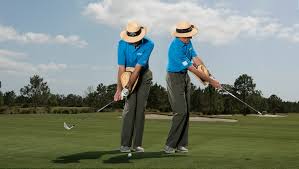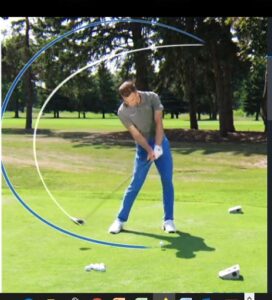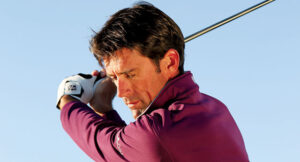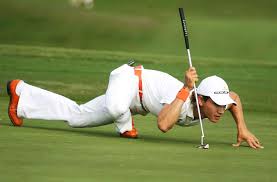Your putter is designed to hit a ball in a straight line. Your task is to choose the right line and speed to make your straight putt go in the hole. So before you ever become a great putter you first need to learn to swing your putter to roll your ball without any side spin across a flat green on a straight line.
After you learn to hit a straight putt you have to apply the following 5 steps to sink every putt. Of course the challenge is to improve your skill in applying the following 5 steps to become a great putter.
The Science Behind a Straight Putt
You have to hit up on your ball to make it start rolling over and the face of your putter must impacting the ball on the balanced center with the swing direction exactly up your target line. To make your ball start rolling at impact, line the ball up so that the back edge is just in front of the center-line between your legs. This allows your putter face to swing up on the ball to make it start rolling from the point of impact.
To swing your putter correctly, rock the large muscles in your shoulders and back with locked elbows and wrists so that only your shoulders swing your putter straight through the point of impact and up your target line. To avoid pulling or pushing your putt, Andrew Rice reminds us to keep our head looking down until the ball is out of your sight. You have to practice this simple motion constantly to trust the straight roll of your putt up your target line.
Put Your Perfect Putting Swing Into Action
1/ Read the Break: Stand on the low point of the green below your ball and appreciate the distance and speed that you need to putt. Then stand behind the lowest end of your putting line (either behind your ball or behind the hole) and bend down to confirm the breaks on your putting line.
2/ Take 1 to 3 practice Putting Swings: Feel the amount of power you need to use to putt at least 12 inches past the hole (to minimize the break at the hole and knowing that short putts never go in the hole).
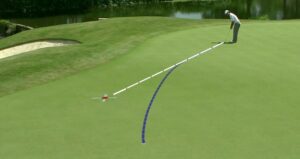
Choose the straight target line for your straight putt. Yes it curves but you have to hit it straight up your target line so focus on the straight swing of your putter.
3/ Choose Your Straight Target Line: In #1 you saw the break or double break. Choose your best estimate for the target line to direct your putt. Line up your body and putter to aim at a point on that straight line to start your STRAIGHT putt.
4/ Stare for 2 Seconds: Load a mental image in your brain by staring at the point that you want to reach as you extend your Straight Target Line to the distance of your putt.
5/ Visually trace a line straight back to your ball, lock your eyes on your ball, as your shoulders swing your putter back and straight up your target line.
You need to FEEL the right swing to putt 12 inches past the hole with your practice swing. Practice your straight putt with your locked wrist using GOLFSTR+. Buy one today at www.GOLFSTR.com.
Golf Truism #1: A two-foot putt counts the same as a two-foot drive.




